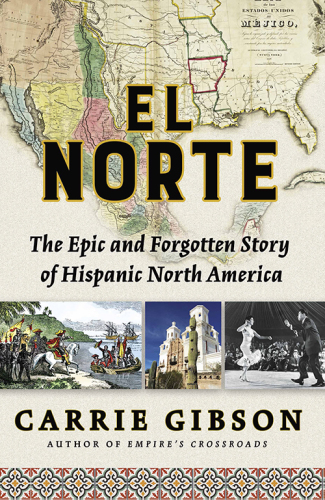
El Norte
The Epic and Forgotten Story of Hispanic North America
کتاب های مرتبط
- اطلاعات
- نقد و بررسی
- دیدگاه کاربران
نقد و بررسی

December 1, 2018
A long but readable history of the Spanish presence in North America from the time of the first European arrival to our own era.What does it mean to be Hispanic? Is one Hispanic if one does not speak Spanish or Portuguese, or does ethnicity extend beyond the borders of language? So Gibson (Empire's Crossroads: A History of the Caribbean from Columbus to the Present Day, 2014) wonders at the opening of her synoptic history of the Spanish in North America. Much of that history has not figured in textbooks until recent times, since, as the author observes, Americanness was largely equated with northwestern European ancestry. Yet that Spanish presence is everywhere. Gibson's first extended look into that history begins at Parris Island, South Carolina, best known as a Marine Corps training center but also the site where Spain and France contended to establish outposts of empire. The author's account includes well-known historical figures such as Christopher Columbus and Bartolomé de Las Casas, the latter a cleric who decried violence against the Indigenous people of Mexico and inadvertently helped promote the "Black Legend" of Spanish avarice and tyranny. Refreshingly, however, Gibson also embraces lesser-known figures such as the French cartographer Jacques Le Moyne de Morgues, whose engravings introduced European readers to scenes of Native American life, and Po'pay, the organizer of a revolt of Pueblo Indians against the Spanish in New Mexico in 1680. Interestingly, as Gibson notes, Po'pay is now one of the two people from New Mexico's history depicted in the hall of statues in the U.S. Capitol, while controversy has arisen around one of California's representatives, the missionary Junipero Serra, who has since been implicated in violence against his native charges. Gibson soundly concludes that the history of the Spanish "is central to how the United States has developed and will continue to develop," lending further utility to her work.Though much of this history is well-documented in the scholarly literature, it's undeniably useful to have it in a single survey volume for general readers.
COPYRIGHT(2018) Kirkus Reviews, ALL RIGHTS RESERVED.

Hispanic peoples and cultures have shaped North America for 500 years, ever since Spanish explorer Juan Ponce de León landed in what is today Florida in 1513. Gibson (Empire's Crossroads) delivers a timely reminder that Anglos are but one European wellspring of U.S. national identity. With insight and verve, the author weaves the myriad Hispanic/Latino influences on North American histories and cultures, addressing everything from immigration, wars, civil rights, tacos, and salsa, along with figures such as Fidel Castro and Cesar Chavez. She further recounts stories elided from public memory, chronicling mass lynchings of Mexicans in Texas; uprisings and bombings waged by Puerto Rican nationalists; and the history of Tampa's Ybor City neighborhood, home to Cuban émigrés long before Miami's Little Havana. Gibson contends that Anglos and Hispanics share the same centuries-old story of North America--a memory vital for our time of border walls and racist rhetoric. Few historians have attempted so sweeping and holistic a survey. Though Gibson can be more detailed about political events than the intersection of Anglo and Hispanic cultures, her evidence is clear: Latin America includes North America. VERDICT A thorough, relevant, and insightful survey of Hispanic North America.--Michael Rodriguez, Univ. of Connecticut, Storrs
Copyright 1 Library Journal, LLC Used with permission.
Starred review from January 1, 2019
Gibson (Empire's Crossroads, 2014) has written an ambitious history of the U.S. that focuses on the country's often overlooked Hispanic origins. Her quest begins in the present day Mexican border town of Nogales, Arizona, and comes almost full circle to her hometown, Dalton, Georgia, where Mexican immigration has brought profound changes. Gibson covers five centuries of events, people, and immense cultural shifts, from the Spanish conquistadors' exploits in Mexico, Florida, and the Atlantic coast to the wars and growing pains of independence to the significant U.S. expansion according to so-called manifest destiny to the upheavals of the twentieth century. Throughout, Gibson gives full personhood to indigenous groups and tribes, placing their experiences in context, and she takes care to elucidate the evolving concept of race and the toxic trope of the U.S. as a white nation, an idea that stubbornly refuses to fade, resurfacing in our own divisive times. The chapter on Texas offers a key reminder that at one time Anglos themselves were illegal aliens, defiantly ignoring Mexico's laws against slavery. Well-organized and containing useful maps, a time line, selected bibliography, and notes, Gibson's exhaustively researched and well-written chronicle is an essential acquisition for all American history collections.(Reprinted with permission of Booklist, copyright 2019, American Library Association.)

























دیدگاه کاربران